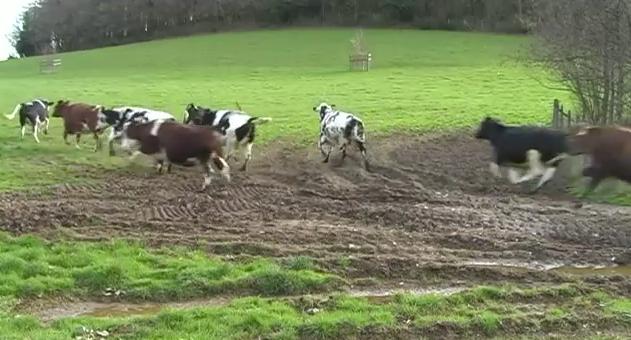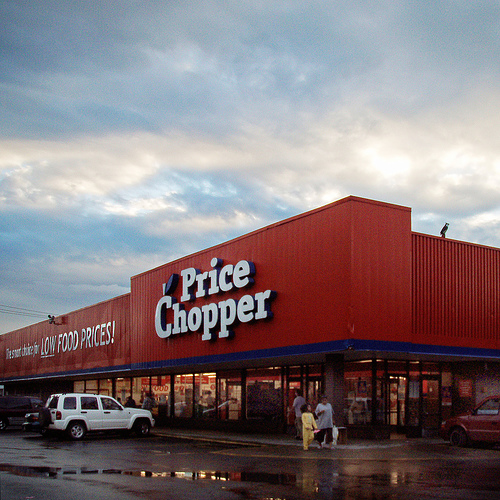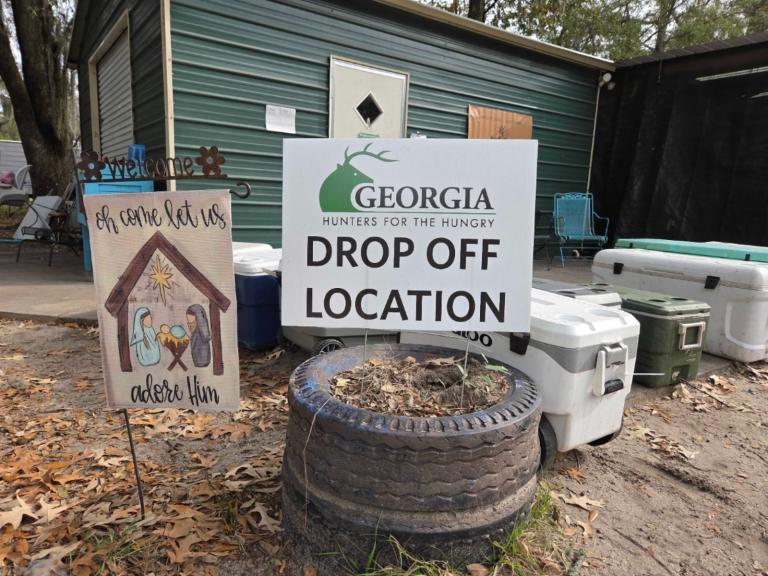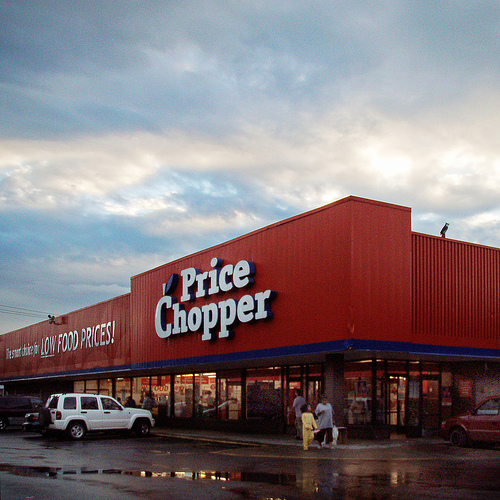 This pastured piggy went to Price Chopper.Photo: Kevin SteeleIt is time to make local passe. It is time to make regional the new local. Enough of farmers markets, CSAs, and direct on-farm sales. Yes, they are exciting — they feel like they are getting us somewhere. And, to be honest and give them their due, they have gotten us somewhere. The reality, however, is that they will never get us there, whither goest we must if we want to make a change — real change. I will say it as straight as I can: I want to see my pork in Price Chopper (a supermarket).
This pastured piggy went to Price Chopper.Photo: Kevin SteeleIt is time to make local passe. It is time to make regional the new local. Enough of farmers markets, CSAs, and direct on-farm sales. Yes, they are exciting — they feel like they are getting us somewhere. And, to be honest and give them their due, they have gotten us somewhere. The reality, however, is that they will never get us there, whither goest we must if we want to make a change — real change. I will say it as straight as I can: I want to see my pork in Price Chopper (a supermarket).
Can this be done with integrity? Yes, yes it can. But, you’ll need to have faith and let me, the friendly face you like to see at the farmer’s market, recede into the background again, let me fall out of the limelight into the limeless light of the sun shining brightly on me and the critters living lovely on the fields.
Wither goest? To work: to build infrastructure enabling us to regionalize our farm and food systems.
What infrastructure? Here’s a list:
• Regional distribution:
- Trucking and rail, and yes, where appropriate, even barge
- Distribution hubs (logistics and storage) to gather produce into regionalizable quantities
- Regional distribution outlets
- A plethora of mom and pop butchers
- A plethora of mom and pop groceries
- Supermarkets
• Regional wholesale markets and wholesale distributors without which regional distribution infrastructure is fruitless
• Regional processing:
- Slaughterhouses with smallish to mid-sized kill floors
- Mid-sized packing plants to break carcasses into primals and/or all the way down to retail cuts
• Regional-scale production infrastructures:
- Scaled-up farms producing enough that when gathered by the regional distribution infrastructures can consistently and reliably supply regional distribution outlets
Creating a regionally directed, ecologically sound food system that’s accessible to a broad swath can be done with integrity and with no loss of animal, farmer, or consumer welfare; and it must be done.
How much food consumed in the United States is produced under ethical, ecologically sound conditions — 1 percent? Two percent or even three? Is that enough for you? It’s not for me. I want 30 percent. But, to get there, we need to get my pork in front of the consumer, not the consumer in front of my pork. It’s as simple as that.
When I started farming, just a few years ago, I had one goal, to know every single person that I sold every single piece of meat or whole or half animal to, to see them in person, to look into their eyes as meat and money changed hands. I believed, very strongly, that this face-to-face farming was the proper response to the ills of a century and a half of agricultural industrialization, the last quarter century of which had accelerated to an absolutely dizzying pace.
At first, I loved it. Every person I met was so excited about local agriculture. Most of them could barely contain themselves; they were bubbling over with genuine enthusiasm and sheer delight in the visceral emotionality of making food choices and cultural choices that really mattered. Some would gush about all things local farmish. Some would be thoughtful, pensive even. Some would excitedly jabber about farms, food, flavors, tastes, textures, smells, sounds. Some were shy. Some were absolutely matter of fact, acting as if they had been buying meat directly from a farmer for their entire lives. All seemed sure that we were doing the right thing: We were doing it like grandma did, and that was good.
And I believed it too. I believed that we were returning to a pre-World War II model of farm and food systems. I believed that before WWII all beef was grassfed (not true). I believed that before WWII, food distribution was local (not true). I believed that before WWII farmers farmed sustainably (not true). I believed, therefore, that in order to create a viable local farm and food system all we had to do was return to how grandma did it before WWII (not true).
So how could I have strayed so far from the path of localism?
Because I started to read books, old books, primarily on raising pigs on pasture. I was reading old books not because I thought the old books had more wisdom to share necessarily, but simply because after about the mid-1950s to early-1960s the subject of the farm manuals shifted from pasture-based pig farming to confinement pig farming. I learned — continue to learn — a lot from these old books, some of them going back as far as 1805. Other than using contemporary technology like electric fences, I have modeled my farm on what I see as the heyday of pasture-based pig farming, the half century from 1900 to the 1950s.
There was more, however, in these books than information on the day-to-day practice of farming. There was just as much information on marketing, and it was through the information on marketing that my fervent belief that we were doing things as grandma did was shaken, not merely shaken, but toppled, upheaved, pounded to dust.
I discovered that the history we were telling ourselves in the local farm and food systems movement was a myth. It was, in fact, a complete fabrication with no historical basis at all. We had simply wiped G. W. Swift clean from history. We had written away Sinclair’s Jungle (and his socialism!). In our tale, Chicago, New York, Philadelphia were fed by local, or maybe even regional, farms. In our tale, grandma, bought local meat from her neighborhood butcher.
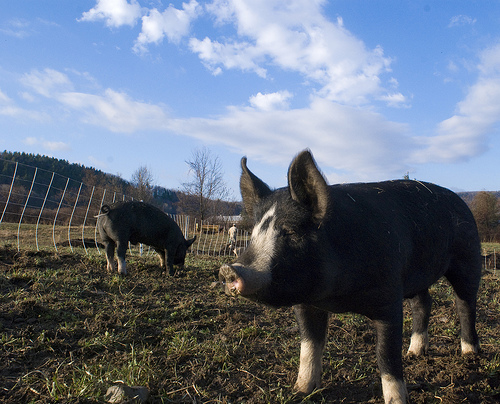 Pigs do their thing on Bob Comis’ farm.Photo: Zach PhillipsMy old books say different. My old books say that we’ve forgotten the perfection of Swift’s refrigerated rail car — which by 1880, made it possible to slaughter hundreds of thousands of cows, millions of pigs, and millions of lambs in Chicago and ship them to the major population centers of the East. In other words, we wrote out of existence the great stockyards of Chicago where millions upon millions upon millions of animals from the Western range lands were slaughtered after being fattened on mountains and mountains of corn, which has also been wiped clean from our history.
Pigs do their thing on Bob Comis’ farm.Photo: Zach PhillipsMy old books say different. My old books say that we’ve forgotten the perfection of Swift’s refrigerated rail car — which by 1880, made it possible to slaughter hundreds of thousands of cows, millions of pigs, and millions of lambs in Chicago and ship them to the major population centers of the East. In other words, we wrote out of existence the great stockyards of Chicago where millions upon millions upon millions of animals from the Western range lands were slaughtered after being fattened on mountains and mountains of corn, which has also been wiped clean from our history.
My old books talk about selling not directly to local butchers, local grocers, or to grandma. They talk about selling at central livestock markets, almost universally, there being here and there an occasional reference to what we would consider local sales. The prices farmers received ebbed and flowed with the supply dropped off for sale at these central markets, because before WWII, before 1900 even, farmers were already selling commodities. We can go back even further than that. One of the major exports of the early American colonies to Britain was barrel upon barrel of brined pork.
So, I can say that I want to see my pork in Price Chopper, because behind the veil of the many myths of the local farm and food systems movement is a reality that we need to deal with. The energy and counter-cultural impulse to buy local, to buy directly from the farmer, is more than the vast majority of our population can or ever will be able to muster — heck, it is more than I can muster half the time! Historically, it has never been done this way. We tell ourselves we are going back to the future, but there is no there back there. We are attempting something brand new wrapped in a false veil of familiarity. If we insist on such a marketing model, local food will never account for more than a pittance of total sales, 1 percent, maybe 2 percent, possibly 3 percent (which is about where organic is right now).
To get beyond niche level, we need to radically change our marketing model. We do not need to sacrifice the integrity of our cultural model. We can and will continue to farm ethically. We can and will continue to be remunerated well enough to make a decent living. We can and will be able to afford to pay our employees living wages. What we cannot do is insist that we farmers look into the eyes of every consumer of local produce.
Newsflash: Grandma bought faceless commodity meat from a nameless farmer. That is not a past I want to return to. I want us to build a new, different, and I do think better, future.
I think we should take the considerable momentum of our farmers market, CSA, on-farm sales culture and direct it toward the broader population. Let’s convince supermarkets to buy local-regional meat, and sell it under our farm names and tell our farm stories. Let’s at the same time find a way to re-proliferate mom and pop butchers and mom and pop grocers who could do the same. These outlets can be a farmer’s proxy. They will know the farmer. They will tell her story. She can even occasionally visit the store and mingle with customers.
I do not think we should get rid of farmers markets, CSAs, and on-farm sales — I think they are lovely. But I do believe now that this more distant, but not quite faceless, way is the way to the future.
It can’t be stressed enough: this way requires a lot of work. We can’t just snap our fingers and go back to doing it how grandma did, because we now know that we don’t want to do it how grandma did it. Instead, we are setting out to do something absolutely new, and in order to get there, we have tremendous infrastructures to build.
Let’s get to work!
